
|   |

|   |
Innovation the highlight of Drishti Dance Festival - G. Ulaganathan e-mail: ulag_nath@yahoo.com January 30, 2017 One of the much awaited dance events in Bangalore, the 12th Drishti Dance Festival can be termed as a festival of innovation. All the three leading artistes of the day came out with interesting, innovative items and the almost full house at Chowdaiah hall on 21st January lapped it up with appreciation. The festival, organized by Bharatanatyam dancer Anuradha Vikranth and her husband T.M. Vikranth, brought together top class performers, Madhu Nataraj and Mohiniattam exponent Gopika Varma, apart from Anuradha herself. 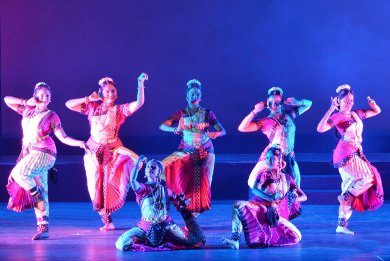 Drishti Dance Ensemble The evening began with the students of Anuradha, Drishti Dance Ensemble presenting the invocatory piece ‘Ganesha Arpana.’ It was perfectly choreographed and the dancers Shubha K, Ramya Bhat, Tincy M, Aishwarya Tolpady, Archana Jois, Nandana B, Apeksha Mall were in attractive costumes. And, the conclusion too was a brilliantly choreographed Mohiniattam performance by the disciples of Gopika Varma. So, the disciples provided the icing on the cake! ‘Mayura Sandesha,’ a Nirupana-Chitra Nritya, so named by the Kuchipudi exponent Veena Murthy Vijay who had conceptualized and directed this item, was the first of the innovations. Mayura Sandesha is a solo dance narrative giving us a feeling of the longing of the tribal heroine Valli, for her beloved hero, Skanda. The ’Chitra Nritya’ technique was used in this feature where Anuradha danced on a spread canvas. And while dancing, she drew the peacock with her feet. The well-presented tale spoke of how Valli, after toying with the idea of sending out various messengers to her beloved, finally settles for the peacock which is dancing with gay abandon when rain drops fall on earth. Playing multiple roles with ease, Anuradha was the personification of grace and style and brought in her rich experience as a Bharatanatyam dancer. The musical score by the highly talented Praveen D Rao and simple props on the stage set the right mood for this romantic odyssey. 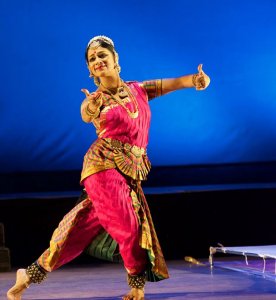 Anuradha Vikranth 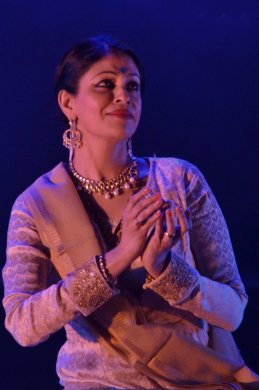 Madhu Nataraj The second innovation of the evening came from Madhu Nataraj’s Natya STEM Dance Kampni. This time it was a contemporary aerial choreography directed by Madhu which saw performers coming down the stage through ropes tied above and create a unique mosaic of images. The pieces were a combination of abstract and mystical works. The first one, Akasha, was a dialogue between earth and sky seen through the lens of a 14th century Sufi song by Amir Khusrau set in a contemporary genre. The second piece was a mixed media rendition of the poetry of the 12th century women mystics - the sharanes. Based on the translations of Basrur Subbu Rao, this choreography fuses Kathak, photo art, animation and soundscapes. There was also an interestingly choreographed number, a sort of tribute to Indian sports today. This was particularly the favourite of the youngsters in the audience and drew repeated claps, another innovation by Madhu. The finale was a pure dance piece in the Kathak style where the dancers created a mosaic of kaleidoscopic imagery! Along with Madhu Nataraj, the talented troupe included Janardhan Raj Urs, Keerthi Kumar, Adrika Subhash, Yonita Jain, Tejesh Kumar and Chethan Raj Urs. 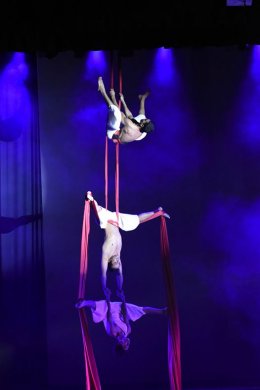 Natya STEM Dance Kampni 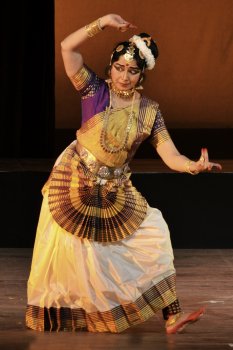 Gopika Varma Lasya Mohana, by the ever graceful Gopika Varma and ensemble was an enchanting presentation of Mohiniattam in true classical format. The innovation here was Topeka bringing to focus two epic women - Draupadi and Gandhari. The venue and time: The battle field in Kurukshetra after the war. Aptly titled ‘sapadam and shapam’ Gopika played many roles in presenting the gripping scenario. Draupadi, after washing her hair with Dushashana’s blood, asks Krishna: “Is this my victory or failure? If it's my victory, I have lost all my children and grandchildren. If it's my failure, then what happens to all the insults and humiliation I have gone through?” Gandhari asks Krishna: “You cheated my children and killed all, at least you could have spared 1 out of 100 for these old parents to do the last rites ...” Then she curses Krishna. “You will also die uncared for, unattended to and no one to weep for you.” Gopika Varma’s rich emotions and slow, changing moods were brilliantly conveyed and she succeeded in taking the audience along with her to the days of Mahabharata and the battlefield. A moving experience indeed. On this occasion Guru Padmini Ravi from Bangalore and Bala Devi Chandrashekar from New Jersey were felicitated with Drishti Puraskar for their contribution to the field of dance. 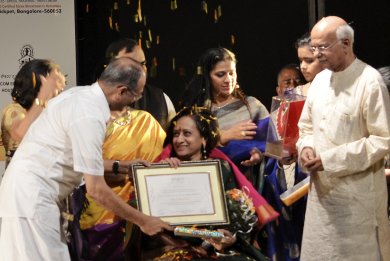 Guru Padmini Ravi 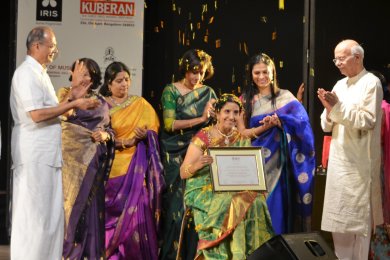 Bala Devi Chandrashekar G. Ulaganathan is a senior writer and journalist based in Bangalore. |